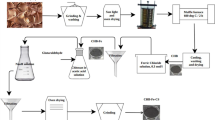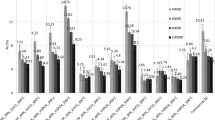Abstract
Large amounts of spent coffee grounds are discharged from food industries, for example, during the instant coffee manufacture. Although part of them is reused as compost and animal feed, most of the coffee grounds are burned as a waste. However, this material can be used as a biosorbent for xenobiotics removal. Spent coffee grounds were magnetically modified by contact with water-based magnetic fluid. This new type of magnetically responsive biocomposite materials can be easily separated by means of commercially available magnetic separators or strong permanent magnets. Magnetic coffee grounds can be used as an inexpensive magnetic adsorbent for the removal of water-soluble dyes. Seven dyes (crystal violet, malachite green, amido black 10B, Congo red, Bismarck brown Y, acridine orange and safranin O) were used to study the adsorption process. The dyes adsorption could be described with the Langmuir isotherm. The maximum adsorption capacities reached the value 73.4 mg of dye per g of dried magnetically modified coffee grounds for acridine orange; it corresponds to 276.6 μmol g−1. This adsorbent can also be used for magnetic solid-phase extraction of crystal violet from extremely diluted solutions. To conclude, magnetic modification of spent coffee grounds resulted in the formation of a new, promising adsorbent for selected xenobiotics removal.





Similar content being viewed by others
References
Pelupessy W (2003) Environmental issues in the production of beverages: global coffee chain. In: Mattsson B, Sonesson U (eds) Environmentally-friendly food processing. Woodhead Publishing Limited, Cambridge, pp 95–115
Silva MA, Nebra SA, Silva MJM, Sanchez CG (1998) The use of biomass residues in the Brazilian soluble coffee industry. Biomass Bioenerg 14:457–467
Tokimoto T, Kawasaki N, Nakamura T, Akutagawa J, Tanada S (2005) Removal of lead ions in drinking water by coffee grounds as vegetable biomass. J Colloid Interface Sci 281:56–61
Adi AJ, Noor ZM (2009) Waste recycling: utilization of coffee grounds and kitchen waste in vermicomposting. Bioresour Technol 100:1027–1030
Stahl H, Turek E (1991) Acid hydrolysis of spent coffee grounds to produce d-mannose and d-mannitol, in proceedings of the 14th ASIC Colloquium. ASIC, Paris, pp 339–348
Kondamudi N, Mohapatra SK, Misra M (2008) Spent coffee grounds as a versatile source of green energy. J Agric Food Chem 56:11757–11760
Kumar U (2006) Agricultural products and by-products as a low cost adsorbent for heavy metal removal from water and wastewater: a review. Sci Res Essays 1:33–37
Fiol N, Escudero C, Villaescusa I (2008) Re-use of exhausted ground coffee waste for Cr(VI) sorption. Sep Sci Technol 43:582–596
Djati Utomo H, Hunter KA (2006) Adsorption of heavy metals by exhausted coffee grounds as a potential treatment method for waste waters. E-J Surf Sci Nanotech 4:504–506
Djati Utomo H, Hunter KA (2006) Adsorption of divalent copper, zinc, cadmium and lead ions from aqueous solution by waste tea and coffee adsorbents. Environ Technol 27:25–32
Yasuda M, Sonda T, Hasegawa N, Kumagawa K (2003) Removal of heavy metals with fresh and used coffee grounds. J Home Econ Jpn 54:827–832
Franca AS, Oliveira LS, Ferreira ME (2009) Kinetics and equilibrium studies of methylene blue adsorption by spent coffee grounds. Desalination 249:267–272
Nakamura T, Hirata M, Kawasaki N, Tanada S, Tamura T, Nakahori Y (2003) Decolorization of indigo carmine by charcoal from extracted residue of coffee beans. J Environ Sci Health A 38:555–562
Namane A, Mekarzia A, Benrachedi K, Belhaneche-Bensemra N, Hellal A (2005) Determination of the adsorption capacity of activated carbon made from coffee grounds by chemical activation with ZnCl2 and H3PO4. J Hazard Mater 119:189–194
Nakanishi A, Tamai M, Kawasaki N, Nakamura T, Araki M, Tanada S (2002) Characterization of water adsorption onto carbonaceous materials produced from food wastes. J Colloid Interface Sci 255:59–63
Safarikova M, Safarik I (2001) The application of magnetic techniques in biosciences. Magn Electr Sep 10:223–252
Safarik I, Safarikova M (2002) Magnetic nanoparticles and biosciences. Mon Chem 133:737–759
Safarikova M, Safarik I (1999) Magnetic solid-phase extraction. J Magn Magn Mater 194:108–112
Safarikova M, Ptackova L, Kibrikova I, Safarik I (2005) Biosorption of water-soluble dyes on magnetically modified Saccharomyces cerevisiae subsp. uvarum cells. Chemosphere 59:831–835
Yavuz H, Denizli A, Gungunes H, Safarikova M, Safarik I (2006) Biosorption of mercury on magnetically modified yeast cells. Sep Purif Technol 52:253–260
Bolto BA (1996) Magnetic particle technology: desalination and water reuse applications. Desalination 106:137–143
Massart R (1981) Preparation of aqueous magnetic liquids in alkaline and acidic media. IEEE Trans Magn 17:1247–1248
Kiwada H, Sato J, Yamada S, Kato Y (1986) Feasibility of magnetic liposomes as a targeting device for drugs. Chem Pharm Bull 34:4253–4258
Safarik I, Lunackova P, Mosiniewicz-Szablewska E, Weyda F, Safarikova M (2007) Adsorption of water-soluble organic dyes on ferrofluid-modified sawdust. Holzforschung 61:247–253
Usher KM, Shaw JA, Kaksonen AH, Saunders M (2010) Elemental analysis of extracellular polymeric substances and granules in chalcopyrite bioleaching microbes. Hydrometallurgy 104:376–381
Mosiniewicz-Szablewska E, Safarikova M, Safarik I (2007) Magnetic studies of ferrofluid-modified spruce sawdust. J Phys D Appl Phys 40:6490–6496
Safarik I, Rego LFT, Borovska M, Mosiniewicz-Szablewska E, Weyda F, Safarikova M (2007) New magnetically responsive yeast-based biosorbent for the efficient removal of water-soluble dyes. Enzyme Microb Technol 40:1551–1556
Safarik I, Safarikova M (2002) Detection of low concentrations of malachite green and crystal violet in water. Water Res 36:196–200
Acknowledgments
This research was supported by the Ministry of Education of the Czech Republic (project OC 09052—Action COST MP0701) and by the Ministry of Industry and Trade of the Czech Republic (Project No. 2A-1TP1/094). The authors thank Frantisek Weyda (Biological Centre ASCR, Ceske Budejovice) for making the SEM image.
Author information
Authors and Affiliations
Corresponding author
Rights and permissions
About this article
Cite this article
Safarik, I., Horska, K., Svobodova, B. et al. Magnetically modified spent coffee grounds for dyes removal. Eur Food Res Technol 234, 345–350 (2012). https://doi.org/10.1007/s00217-011-1641-3
Received:
Revised:
Accepted:
Published:
Issue Date:
DOI: https://doi.org/10.1007/s00217-011-1641-3




